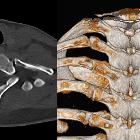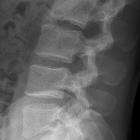Randleistenhernie

















A limbus vertebra is a well-corticated unfused secondary ossification center, usually of the anterosuperior vertebral body corner, that occurs secondary to herniation of the nucleus pulposus through the vertebral body endplate beneath the ring apophysis (see ossification of the vertebrae). These are closely related to Schmorl nodes and should not be confused with limbus fractures or infection.
Epidemiology
Their formation occurs before the age of 18 years, but often they are seen in older adults.
Clinical presentation
Anterior limbus vertebrae are generally asymptomatic and are detected incidentally. Posterior limbus vertebrae are far less common but have been reported to cause nerve compression.
Radiographic features
Limbus vertebrae should be well-corticated, that is they have a sclerotic margin, are triangular in shape and occupy the expected location of a normal vertebral body corner, with a smooth sclerotic subjacent corticated vertebral margin. The 'fragment' of bone will not 'fit' into the adjacent bone as one would normally expect with a fracture and will often appear to be too small.
A limbus vertebra of the anterosuperior corner of a single vertebral body in the mid lumbar spine is the most common presentation. The anteroinferior and posteroinferior corners are seen far less frequently. Occasionally it may be seen in the thoracic spine.
Usually, radiography with or without CT or MRI is sufficient for diagnosis. Initially, the etiology was confirmed with discography where contrast extends into the intraosseous herniation of the nucleus pulposus.
History and etymology
The term limbus is a direct borrowing from the Latin word meaning fringe, as in the edge of something, or hem .
Differential diagnosis
Consider
- intercalary bone: ossification is in the anterior annular fibers of an intervertebral disc
- acute fractures: should have an adjacent perivertebral hematoma
- limbus fracture
- teardrop fracture (cervical spine)
- degenerative disease of the spine
- infection: adjacent cortical loss and soft tissue mass
Siehe auch:
- intercalary bone
- angeborene Wirbelanomalien
- Schmorl'sche Knötchen
- Morbus Scheuermann
- Frakturen der Wirbelsäule
- Nucleus pulposus
- Wirbelkörper Randleisten
- posteriorer Limbus vertebrae
- Randleistendefekt
- Randleisten nicht verschmolzen
- Randleistenfrakturen
- cervical limbus vertebra
und weiter:

 Assoziationen und Differentialdiagnosen zu Randleistenhernie:
Assoziationen und Differentialdiagnosen zu Randleistenhernie: nicht verwechseln mit:
nicht verwechseln mit: 






